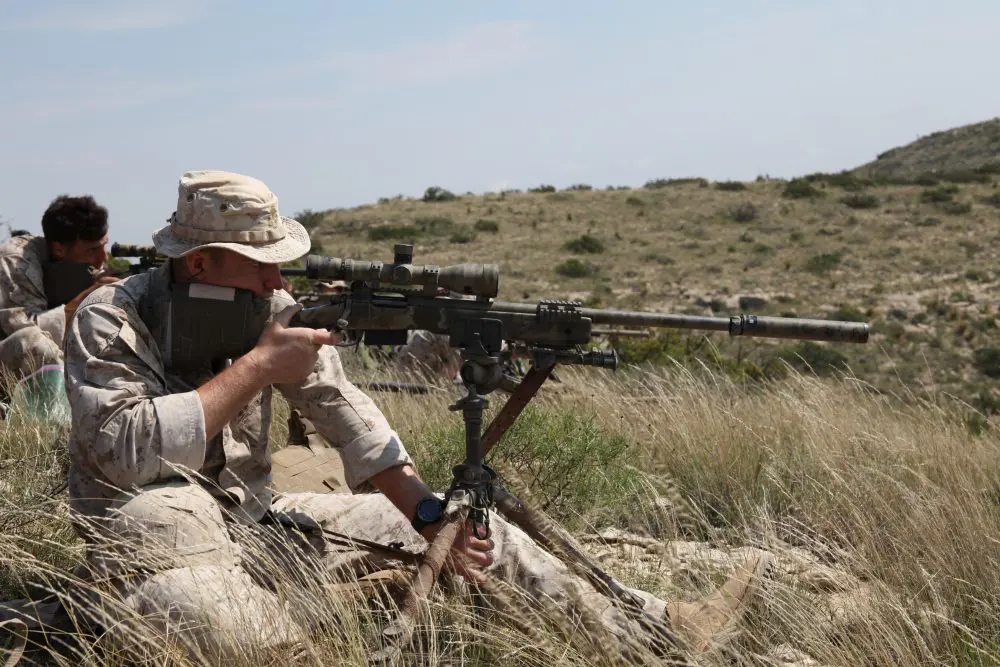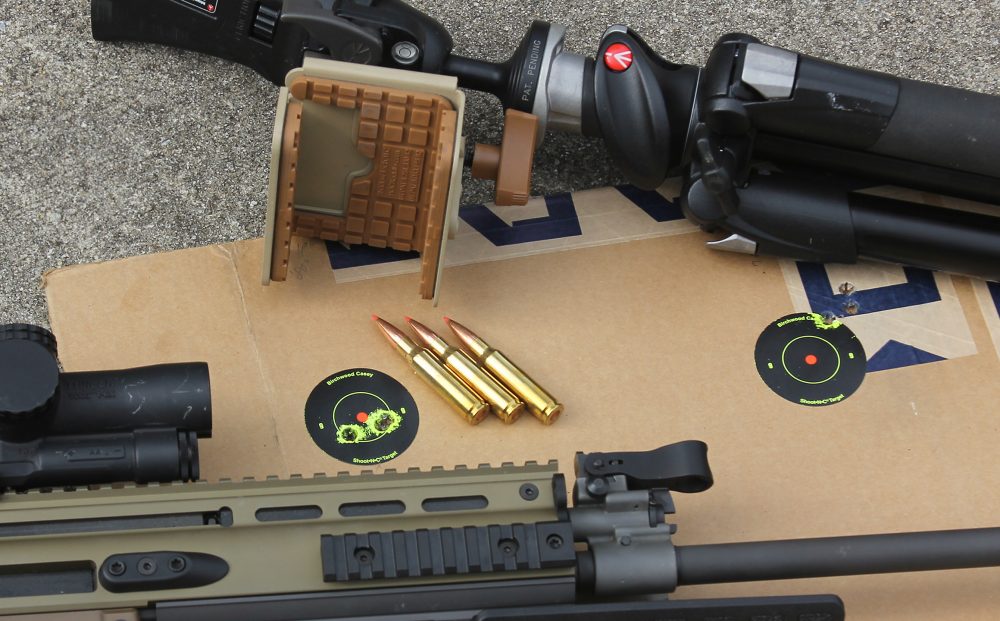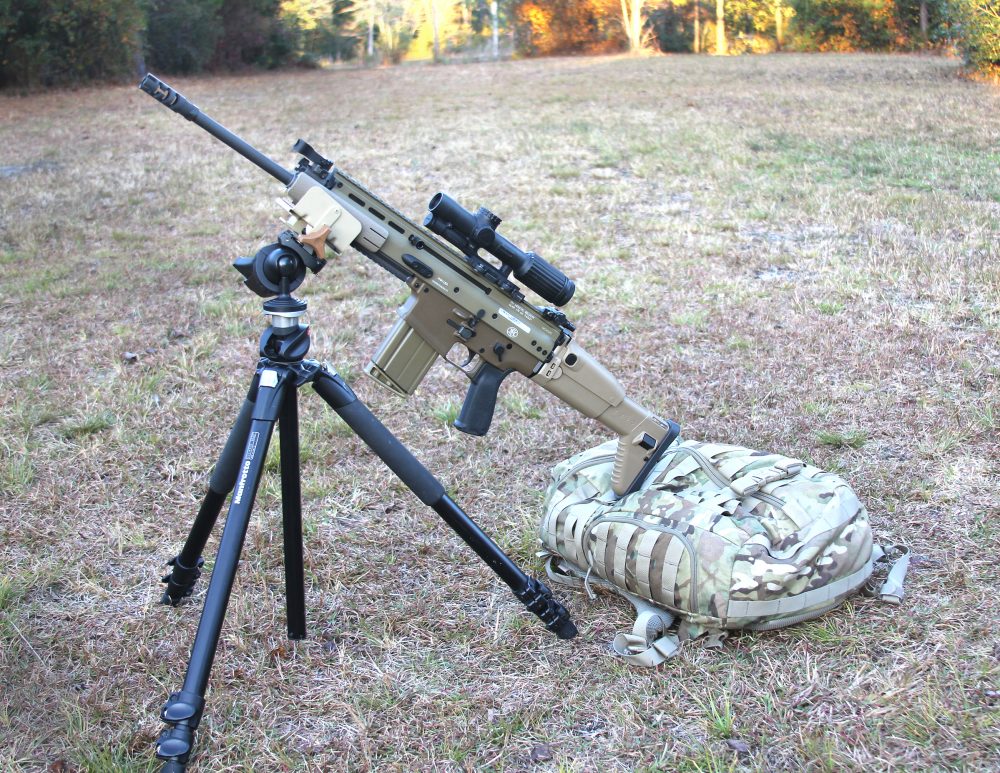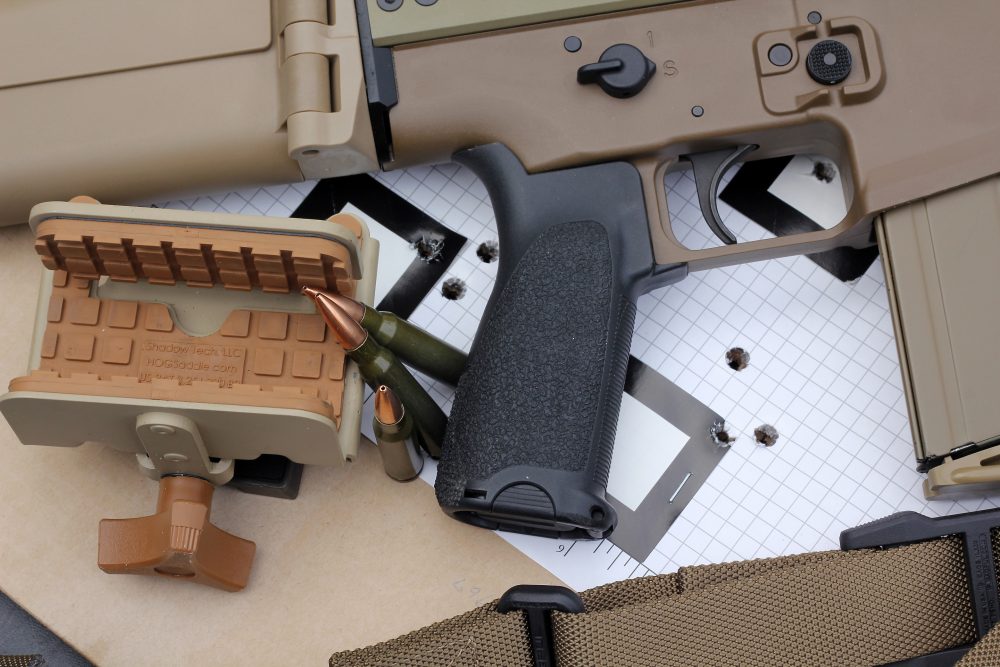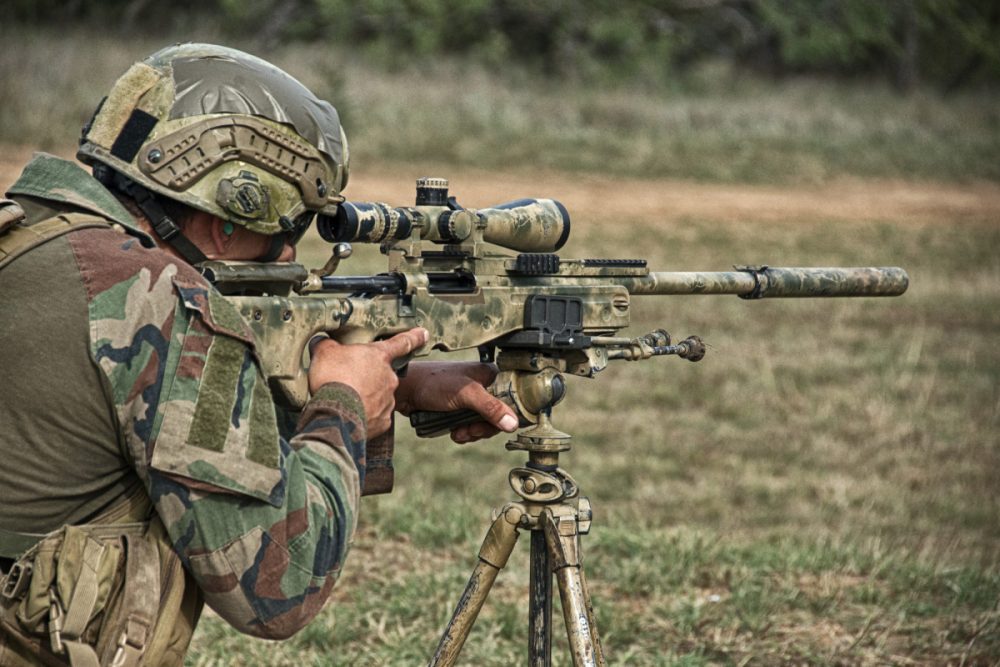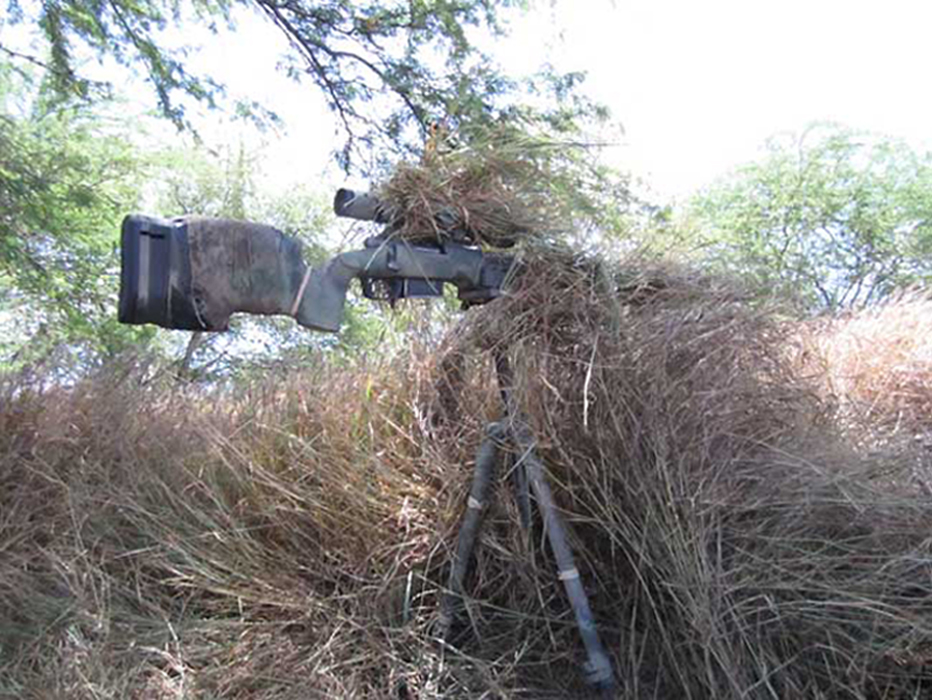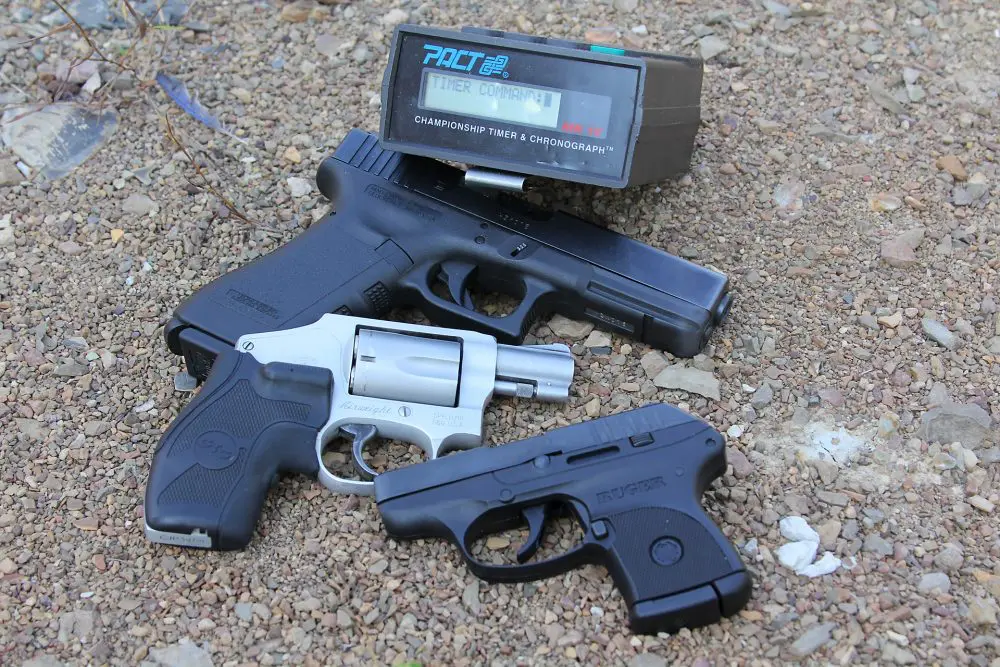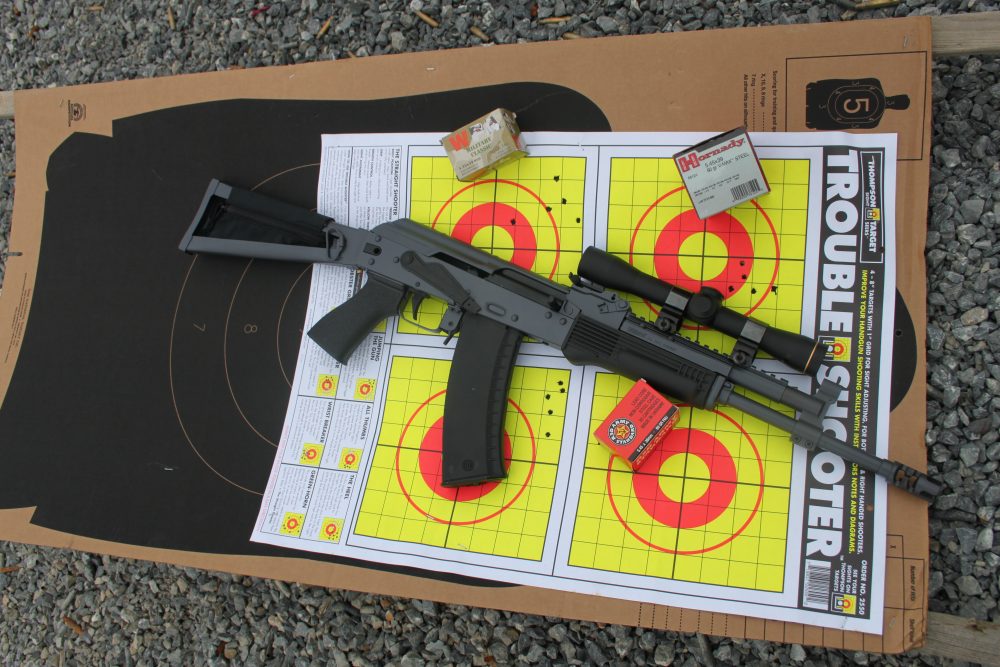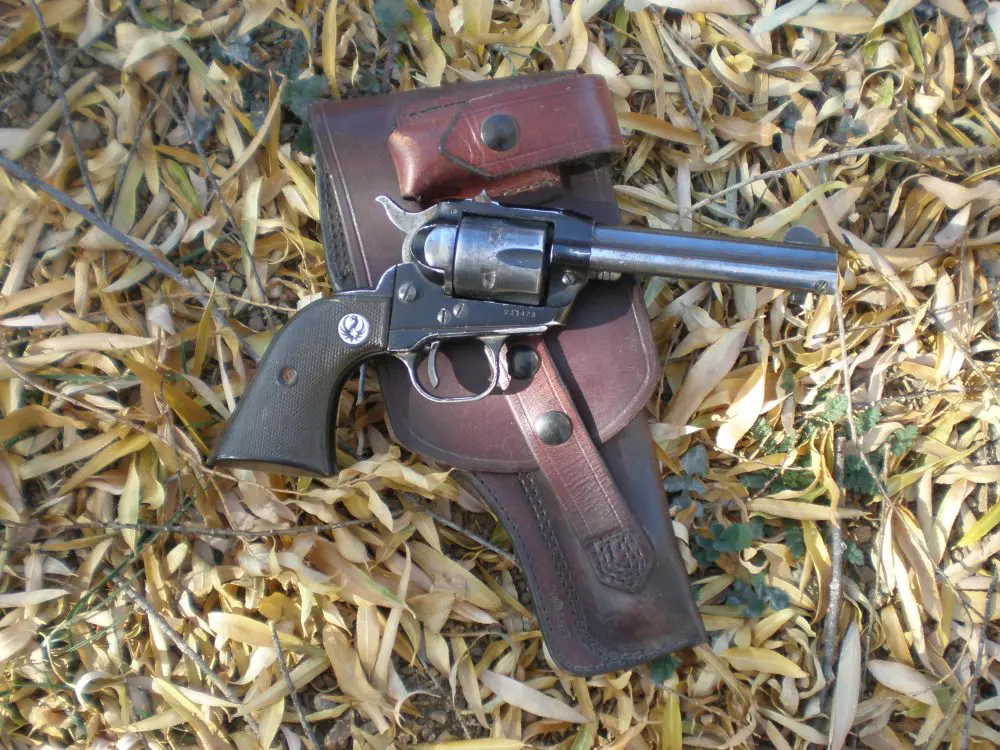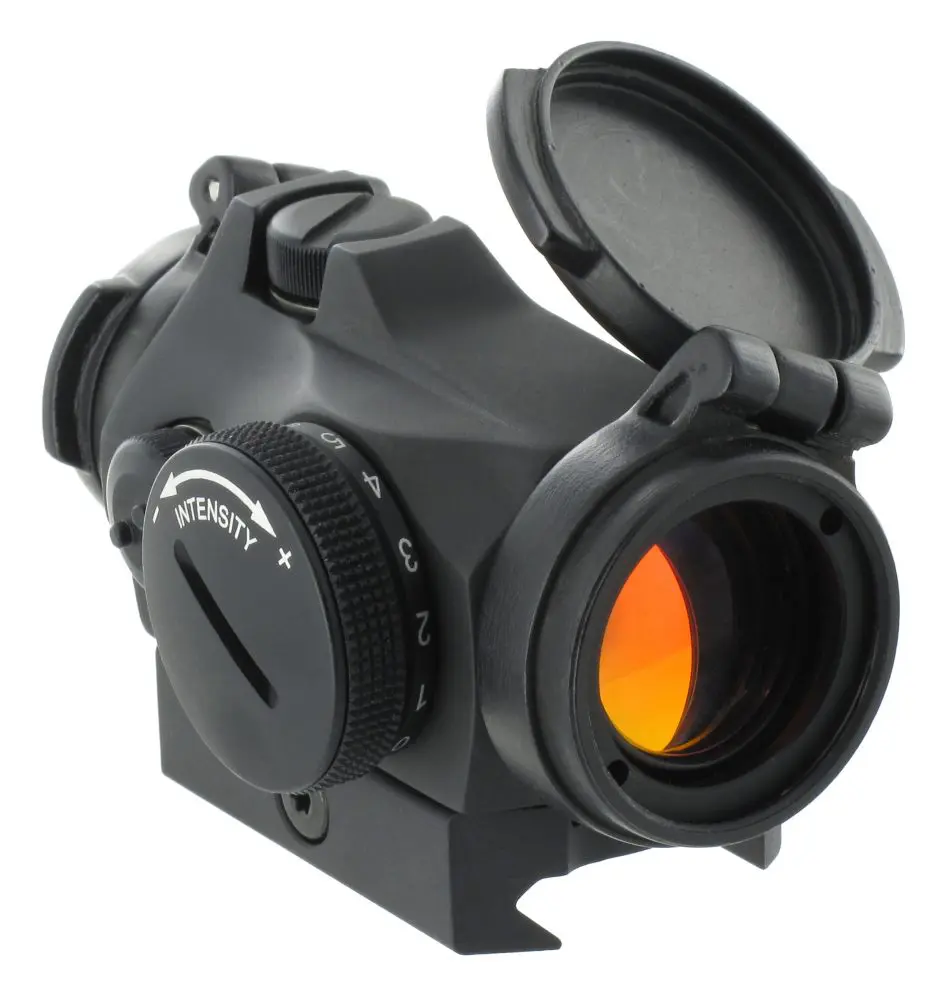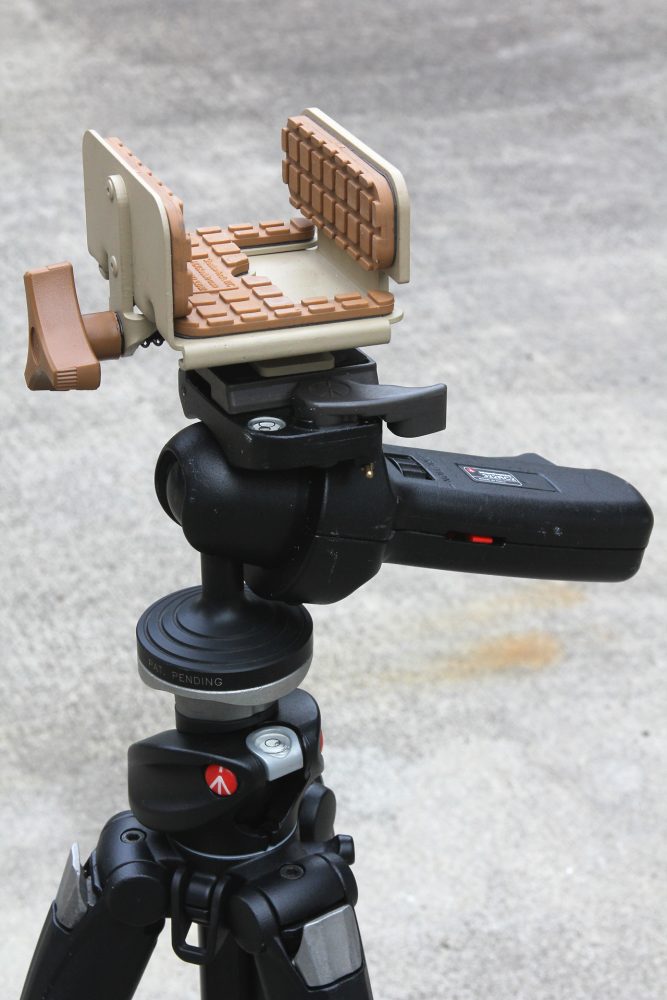
Precision shooters always seek the warm embrace of Mother Earth for the long shot. But the shot very often precludes lying down on the job.
For every textbook ideal belly shot on a rooftop set-up, there are probably half a dozen that require some other positional approach. I have been in and around a number of observation posts and sniper positions where a prone set-up that allows the shooter to employ a rest or bipod was the exception. The shooters improvised as much support as the position and situation allowed, from hasty sandbags or packs built up the required height to (no kidding) office-type desks carried up to rooftops to build a benchrest-inspired setup.
The tripods that snipers used for their spotting scopes often figured into improvised positions, so much so that guys started experimenting with the tripod in earnest. A recent product invented by a Marine Scout Sniper takes that to the next level and has largely replaced the angst and jury rig-athon shenanigans of trying to get enough support for the shot.
Table of Contents
SHADOW-TECH HOG SADDLE
The Shadow-Tech HOG Saddle is a machined aluminum vise that attaches to standard tripod threads (either 1/4×20 or 3/8×16). The jaws of the vise are covered in a firm ¼-inch thick urethane waffle that clamps tightly to the weapon and dampens vibration transmitted to the weapon as well as helps tame the bounce transmitted into the system from recoil.
The saddle is overbuilt, tightening around a monster screw that is built to withstand the abuse of being torqued onto rifles hard mission after mission. A remarkably simple device, the HOG Saddle swept the sniping community in record time. Now standard issue with the USMC M40A5 sniper rifle, the ShadowTech saddle went from prototypes sent out to Scout Sniper buddies to a game-changing, must-have tech in less than three deployment cycles.
The HOG Saddle clamps the rifle firmly into its jaws, allowing the shooter to adjust the position almost infinitely with the better tripods in wide use. The Manfrotto brand is the clear frontrunner in tripods, its carbon-fiber versions being issued to most of the special reconnaissance community for good reason. As training techniques and employment tips catch up to the potential, the saddle/tripod combo brings shooters far outranging previous first-round hits from positions other than prone.
.88-inch 100-yard group for three Black Hills 155 A-MAX using PIG Saddle fired from sitting.
THE PIG
I saw an early prototype in testing and thought I’d experiment with one of the production models. I chose the PIG Saddle, different from the HOG in that it is a less expensive stamped steel rather than machined aluminum model with a polymer torque knob. The PIG is slightly heavier at 1.4 pounds weight to the HOG’s 15 ounces.
As a simple test to quantify potential, I shot a SCAR 17S with the saddle over the space of a few weeks. The .308 SCAR is a battle rifle, not a sniper rifle, but I was already working with it and thought that any potential it showed would translate very well to all users.
SCAR 17S with 1-6X VCOG used to test PIG Saddle using Hornady and Black Hills loads.
Many of the SCAR “Heavies” in service have been employed as a hybrid battle/designated marksman rifle. All that I am familiar with have ranged from acceptably to impressively accurate. The results with the SCAR would suggest even more performance available to a true sniper or special-purpose rifle.
The FNH rifle was wearing a Trijicon VCOG 1-6X scope with the segmented circle reticle, a very good match to the rifle. Ammunition was predominantly Black Hills 155-grain loaded with Hornady A-MAX bullets. The load covers both battle rifle and open-air precision scenarios very well with match accuracy, a flat trajectory within the weapon’s normal envelope, and explosive expansion.
PIG Saddle nearly turned a lawnchair into a benchrest: two consecutive sub-MOA groups fired from sitting with PIG Saddle and 155-grain Hornady Steel Match.
BELLY UP TO THE LINE
I first set a baseline from prone with the SCAR using a LaRue LT706 bipod and rear bag. I am no stranger to prone, and the rifle locked down into a very secure position. The SCAR had a crisp but frustratingly heavy 7.5-pound trigger to work through, requiring a lot of effort to let the rifle “be” while I pressed as smoothly through as possible.
Over several range sessions, I fired numerous three-round groups at 100 yards. The best I could manage from the ground was a 1.07-inch cluster for one group. The worst was a 1.7-inch spread, with the average and the most common result being a 1.3-inch triangle.
USMC Scout Sniper uses HOG Saddle with M40 to clear line of sight to target. Photo: USMC
SITTING DOWN WITH THE PIG
I dropped the SCAR into the PIG Saddle, tightened the nut until the pads grabbed onto the Picatinny rails, and adjusted my tripod to a comfortable height. The Manfrotto 322 RC2 ball head allowed simple final adjustments to get the rifle onto target.
I was sitting in an umbrella-type camping/tailgate chair while leaning into the rifle with my elbows resting on my knees. My support hand was nested under the toe of the buttstock. There was a tiny bit of sway in the position, but the VCOG’s center crosshair gently and consistently hovered near the two-inch aiming point I was using.
The first three shots from the PIG Saddle stacked into 1.28 inches. I made a slight correction in the VCOG’s turrets to walk the group into the center of the target and fired another three. The three Black Hills whistled into the target, cutting a pretty cluster within the one-inch center of the spot and .8-inch center to center. Hmmm…
Feeling pretty good, I broke out the timer for the third group. I was shooting for the three shots in ten seconds sniper standard from a previous unit. The heavy trigger dragged my time out to 14.2 seconds for a .76-inch group. But even from a casual sitting position, the saddle and tripod took the recoil well, allowing the SCAR to get back on target quickly. Over several sessions, the SCAR averaged a scant .97-inch for all groups from sitting. The largest was one 1.7-inch triple, and one sequence of four successive groups each went sub-minute of angle.
I don’t think I could have squeezed much more out of that SCAR from a concrete bench. Probably some, but I suspect the difference would have been hidden in the group-to-group variation for perhaps a slightly better average or maybe the largest group might have shrunk somewhat.
Regardless, being able to beat MOA from a lawn chair with a battle rifle benighted with a poor trigger indicates what the fuss is all about with the Shadow-Tech saddles.
MARSOC Sniper using Saddle with Mk 13 .300 Win Mag at Advanced Sniper Course. Saddle has been eagerly adopted by snipers and put to use worldwide. Photo: MARSOC
STAND-UP HITTING
I next extended the tripod out and played around with the leg positioning to make a go at standing groups. The rifle was stable but very sensitive to my position. I had a two-point adjustable Magpul MS1 sling on the rifle and flipped it over to the off side to run from the butt around my shooting side tricep and back around to the support side of the rifle. This helped stabilize the position a little further.
I was glad for the range of adjustments on my tripod and its rock-solid stability. It took a little set-up to get to the perfect height where I had maximum bone support to put behind the rifle. It looked like there is significant room for technique and little tweaks to lock the rifle down as much as possible, but after a few dry snaps, I chambered an A-MAX and launched a group to see what I had.
The first attempt put three holes in 1.58 inches, all three within the two-inch target and to the same point of aim as sitting. The reticle movement was very noticeable at six power on the VCOG but the tripod-mounted rifle launched good groups. The worst was a 1.8-inch trio that was similar to the outliers from prone and sitting. The best was a see-it-to-believe-it .49-inch cloverleaf. The SCAR followed that one with a .57-inch cluster. Average for all standing groups was 1.1 inches.
I will readily admit that, while the shots broke well and felt good, I was much less confident from standing than I had been from sitting. But as a first attempt, the results speak to the considerable promise the system has.
Prone is often not available to the shooter. Shadow-Tech saddle and tripod provide options for a precision shot off the ground. Photo: Shadow-Tech
NUMBERS
The data literally jumps off the page to embrace the tripod-mounted PIG Saddle. Standing or sitting to basically MOA groups from a battle rifle with a trigger that weighs more than the base rifle? Shadow-Tech may be onto something here…
I am still trying to reconcile the fact that the groups from the saddle undercut my best prone efforts. My theory is that I was able to get a more natural head position behind the scope in the saddle-supported positions, since the VCOG has a pretty tight eyebox at six power. However, it may just as easily be the dice roll that is comparing three-shot groups.
The prone groups were more consistent, but the strange thing in this case was that the consistency only prevented the sub-minute groups the other two positions saw while still allowing one outlier group at 1.7 similar to the saddle’s from both positions. Things like this drive riflemen crazy.
It is worth noting that this is a sample of one. Even though the shooting occurred on multiple similar days, with the same rifle and shooter using the same lot of proven consistent Black Hills ammo, it speaks to potential.
UTILITY
That potential is pretty obvious in the tactical arena, when line of sight to the target may dictate the height of the shooting position. As sniper schools adopt training segments incorporating the saddle, I expect we will see first-round hit potential soar from positions that used to give shooters cause for concern. I can’t think of any recent piece of commercial off-the-shelf shooting gear that has so quickly gone from individually conceived solution to widespread adoption. Individual shooters as well as units have rushed to use the device.
I have since used the saddle to replace my rifle rests and bags for zeroing and grouping other rifles, and have been very happy with it. I can picture the saddle having a real place in a hunting blind or stand overlooking a potentially long shot.
And, although not what it was designed for, I can just as easily see the saddle being pressed into service in the field as a vise to hold an upper or lower receiver for maintenance or repairs.
SOURCE
SHADOW-TECH, LLC
(913) 602-0665
www.hogsaddle.com
